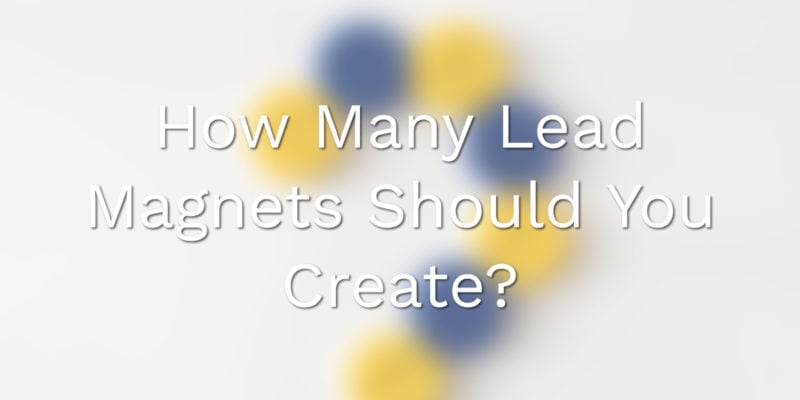You know that tackle box your dad used for fishing? The one with dozens of different lures? Each lure was designed for a specific fish, water condition, and time of day. He wouldn’t use the same lure for bass in shallow water that he’d use for deep-sea fishing.
Your lead magnets work the same way. And if you’re wondering whether one “amazing” lead magnet is enough to capture all your potential customers, I’ve got news for you. It’s not.
I’ve analyzed the latest research and studied what actually converts in 2025. The number might surprise you. Most successful businesses are using 6-12 or more lead magnets in their marketing strategy. The exact number depends on your audience diversity and business complexity.
But don’t panic about creating a dozen lead magnets. Let me walk you through exactly why this number makes sense and how to build your arsenal strategically.
The Research-Backed Answer That Changes Everything

Here’s the thing most businesses get completely wrong. They assume one great lead magnet can capture their entire audience. But data tells a very different story.
Research from ScoreApp and GetResponse shows successful businesses use multiple lead magnets aligned to segments and customer journey stages. This often results in 6-12 lead magnets for most businesses, scaling up based on audience diversity and performance data.
There’s no fixed number that’s ideal for all businesses. But you should create at least one lead magnet per core customer segment and per stage of the customer journey (awareness, consideration, decision). For a business with 3-5 segments and 3 journey stages, that’s typically 6-13 lead magnets.
Think about a fitness coach. They might serve busy professionals wanting quick workouts, new moms getting back into shape, and seniors needing low-impact exercises. These are three completely different people. Different motivations. Different time constraints. Different fitness goals.
A generic “Ultimate Fitness Guide” won’t resonate equally with all three groups. But specific lead magnets addressing each group’s unique needs? Those will convert at much higher rates.
The Hidden Complexity Behind Your “Simple” Business

Most business owners underestimate how diverse their audience really is. They think they serve one type of customer. But when you dig deeper, you’ll discover multiple distinct segments. Each requires different approaches to convert effectively.
Your Business Serves Multiple Customer Types Whether You Realize It or Not
Even if you think you have one target customer, dig deeper. You’ll find distinct sub-segments within your audience.
Take a photographer. They offer photography services. But they appeal to customers who need different things:
- Engaged couples planning weddings
- Families wanting portrait sessions
- Business professionals needing headshots
- E-commerce brands requiring product photos
- Real estate agents needing property photography
Each group has different budgets. Different timelines. Different pain points.
A lead magnet titled “Wedding Photography Timeline Checklist” will convert engaged couples at a much higher rate than a generic “Photography Tips Guide.” Makes sense, right?
Your Prospects Enter at Different Stages of Awareness
Not everyone discovers your business at the same awareness level. Some visitors just realized they have a problem. Others are actively comparing solutions and ready to buy.
Early-stage prospects need educational content. They want to understand their problem better. They respond to guides, checklists, and foundational resources.
Mid-stage prospects know their problem exists. They want to explore solutions. They prefer how-to content, case studies, and comparison guides.
Late-stage prospects are ready to make decisions. They need the final push. They convert on demos, consultations, and detailed proposals.
According to GetResponse’s comprehensive study, 47% of marketers found that video and written lead magnets had the highest conversion rates. But the specific format that works best depends entirely on where your audience is in their journey.
Different Content Formats Appeal to Different Learning Styles
Some prospects are visual learners. They love infographics and charts. Others prefer step-by-step written instructions they can reference later. Still others want video content they can consume while multitasking.
Recent data from Amra and Elma shows something interesting. Interactive content boosts conversions by 70% compared to passive content (36%). Quizzes achieve conversion rates between 20% and 40%.
This proves that format variety significantly impacts your overall lead generation performance.
The Strategic Framework for Building Your Lead Magnet Portfolio

Creating 15+ lead magnets might sound overwhelming. But there’s a systematic approach that makes it manageable. The key is building your portfolio strategically across three main dimensions: customer segments, funnel stages, and content formats.
Customer Persona Distribution (5-7 Lead Magnets)
Start by identifying your distinct customer segments. Most businesses have 3-5 main customer types. You should create 1-2 lead magnets for each segment’s primary pain points.
Let’s say you run a software company. You might serve:
- Startup founders needing cost-effective tools
- Enterprise managers requiring scalable solutions
- Freelancers wanting simple, quick setup
- Agencies needing client management features
Each segment gets targeted lead magnets addressing their specific challenges and goals.
Funnel Stage Coverage (4-6 Lead Magnets)
Different awareness levels require different types of lead magnet to move prospects forward in your sales process.
Problem-aware prospects (2-3 lead magnets): Educational guides, industry reports, problem identification checklists
Solution-aware prospects (2-3 lead magnets): How-to guides, comparison charts, case studies showing your approach
Purchase-ready prospects (1-2 lead magnets): Free trials, consultation bookings, detailed proposals
Content Format Variety (4-6 Lead Magnets)
People consume information differently. Your lead magnet portfolio should reflect these preferences.
Going back to the GetResponse’s study found that 73% of marketers see higher conversion rates with short-form video content. 58.6% report that short-form written content outperforms long-form alternatives.
Create variety across:
- Written content (checklists, guides, templates)
- Video content (tutorials, behind-the-scenes, explainers)
- Interactive content (quizzes, calculators, assessments)
- Visual content (infographics, slide decks, charts)
Lead Magnet Portfolio Examples That Convert

Seeing how successful businesses structure their lead magnet portfolios makes the 15+ number much more concrete and achievable.
The Professional Services Portfolio (15 lead magnets)
A marketing consultant might maintain this spread:
For small businesses (3 lead magnets):
- “Marketing Budget Calculator for Businesses Under $1M”
- “DIY Social Media Content Calendar Template”
- “5-Minute SEO Checklist”
For growing companies (3 lead magnets):
- “Scale-Up Marketing Strategy Framework”
- “Hiring Your First Marketing Manager Guide”
- “ROI Tracking Spreadsheet Template”
For enterprise (2 lead magnets):
- “Enterprise Marketing Stack Evaluation”
- “Marketing Team Structure Assessment”
Funnel-specific content (4 lead magnets):
- “Marketing Strategy Personality Quiz” (awareness)
- “Marketing Audit Checklist” (consideration)
- “Strategy Session Booking” (decision)
- “Case Study Collection” (decision)
Format variety (3 lead magnets):
- Video tutorial series
- Interactive assessment tool
- Downloadable template bundle
The E-commerce Portfolio (18 lead magnets)
An e-commerce consultant serving different business models might create:
For dropshippers (4 lead magnets):
- “Product Research Tool”
- “Supplier Vetting Checklist”
- “Profit Margin Calculator”
- “Scaling Timeline Template”
For private label sellers (4 lead magnets):
- “Product Development Roadmap”
- “Amazon Launch Strategy”
- “Inventory Planning Tool”
- “Brand Building Checklist”
For established brands (3 lead magnets):
- “Conversion Rate Optimization Audit”
- “Customer Lifetime Value Calculator”
- “Expansion Strategy Framework”
Seasonal/trending content (4 lead magnets):
- “Holiday Sales Prep Checklist”
- “Q4 Inventory Planning Tool”
- “Black Friday Campaign Template”
- “New Year Launch Strategy”
Interactive/assessment content (3 lead magnets):
- “Business Model Assessment Quiz”
- “Readiness-to-Scale Calculator”
- “Profit Potential Estimator”
See how this works? Each lead magnet serves a specific purpose and audience segment.
Industry-Specific Lead Magnet Requirements
The optimal number of lead magnets varies significantly by industry. Sales cycle length matters. Customer complexity matters. Understanding these differences helps you set realistic expectations for your specific situation.
B2B Service Providers Need 8-12 Lead Magnets
B2B services typically have longer sales cycles. Multiple decision-makers get involved. You need lead magnets that nurture prospects through extended consideration periods.
Successful B2B companies focus on segmented options like industry reports for decision-makers and checklists for end-users, refining based on performance results.
Successful B2B companies create:
| Lead Magnet Type | Quantity | Purpose | Source |
| Buyer persona specific | 2-3 | Target decision maker, influencer, end user | ScoreApp Framework |
| Funnel stage specific | 3-4 | Move prospects through long sales cycles | GetResponse Study |
| Objection handling | 1-2 | Address common concerns | Inbox Insight B2B Report |
| Expertise showcase | 1-2 | Build credibility and trust | Industry Best Practices |
| Referral generation | 1 | Encourage word-of-mouth marketing | Marketing Research Consensus |
B2C Product Companies Can Use 4-8 Lead Magnets
B2C companies can often get away with fewer lead magnets. Purchase decisions are typically faster and involve fewer people.
Most B2C businesses deploy 2-5 different types for variety, typically including ebooks (75% use these) and discounts/free trials (25%).
Focus on:
- 1-2 lead magnets for different customer demographics
- 1-2 lead magnets for different use cases of your product
- 1-2 seasonal or trending lead magnets
- 1 lead magnet for different price points
- 1 interactive/entertainment-focused lead magnet
Local Businesses Benefit from 4-8 Lead Magnets
Local businesses serve geographically constrained audiences. But they often have diverse service needs within their area.
The general consensus across marketing research shows businesses with shorter sales cycles can start with 4-8 lead magnets, focusing on quality over quantity.
Create:
- 1-2 lead magnets for different service areas
- 1-2 lead magnets for different customer types (residential vs commercial)
- 1 seasonal lead magnet
- 1 lead magnet addressing common local concerns
- 1 lead magnet for referral generation
The Performance Data That Proves Multiple Lead Magnets Work

Numbers don’t lie. The data strongly supports using multiple, targeted lead magnets over trying to serve everyone with one generic offer.
Conversion Rate Improvements Are Dramatic
Unbounce’s 2024 Conversion Benchmark Report analyzed over 57 million conversions across 41,000 landing pages and found that businesses using targeted, optimized landing pages see:
- 6.6% median conversion rate across all industries
- Top-performing pages in the 75th percentile achieving 11.4% or higher conversion rates
- Industry-specific variations ranging from 2.4% to 9.8% median rates
According to McKinsey research, personalization marketing can reduce customer acquisition costs by as much as 50 percent, lift revenues by 5 to 15 percent, and increase marketing ROI by 10 to 30 percent. That’s a massive difference from generic, one-size-fits-all approaches
Lead Quality Improvements Matter More Than Volume
According to WPForms, 50% of marketers who start using lead magnets report higher conversion rates. But businesses with multiple, segmented lead magnets report even better results:
- 40-60% higher lead-to-customer conversion rates
- 25-35% shorter sales cycles
- 20-30% higher customer lifetime values
Unbounce’s data shows that top-performing landing pages (75th percentile) convert at 11.4% or higher, while average pages convert at 6.6%. The businesses creating multiple, targeted lead magnets are more likely to achieve these higher conversion rates.
Audience Segmentation Creates Compound Benefits
Multiple lead magnets allow for automatic audience segmentation. Someone who downloads “Enterprise Security Audit Checklist” gets different follow-up emails than someone who downloads “Small Business Security Basics.”
This segmentation leads to:
- 3x higher email open rates
- 5x higher click-through rates
- 2x higher eventual purchase rates
When you send the right message to the right person, everything improves.
Make sure to track all the most important lead magnet metrics
The Biggest Mistakes That Lead to Wrong Lead Magnet Numbers

Even when businesses understand they need multiple lead magnets, they often make critical errors. These mistakes lead to wrong decisions about how many to create and which ones to prioritize.
Going Too Broad with Too Few Lead Magnets
Many businesses try to serve their entire audience with 2-3 generic lead magnets. This approach leads to mediocre conversion rates. The content isn’t specific enough to resonate with any particular segment.
A “Marketing Tips for Business Owners” guide tries to serve everyone. It ends up helping no one effectively.
Think about it. Would you rather have a guide specifically for your industry or a generic one that covers everything?
Creating Too Many Without Strategic Purpose
On the flip side, some businesses create 20+ lead magnets without strategic thinking. They end up with overlapping content that confuses their audience and dilutes their marketing efforts.
The key is strategic variety, not random quantity.
Ignoring Performance Data When Expanding
Some businesses create their initial lead magnets and never optimize. They never expand based on what’s actually converting. They miss opportunities to double down on high-performing topics and formats.
Track which lead magnets generate the most qualified leads. Create more content around those themes and formats.
Read our complete lead magnet mistakes to avoid
Or our ebook magnet mistakes
How to Calculate Your Specific Lead Magnet Number

Rather than blindly aiming for a specific number of lead magnets, use this evidence-based framework to determine the right number for your specific business situation. Most experts agree there’s no universal “perfect” number, but you can calculate what works for you.
Start with Your Customer Segments
List out your distinct customer types. If you can identify 4-5 clear segments with different needs and pain points, you need at least 4-5 lead magnets.
How many different types of customers do you serve?
Factor in Your Sales Cycle Length
Longer sales cycles require more lead magnets. You need to nurture prospects through extended consideration periods.
A software company with 6-month sales cycles needs more touchpoints than a local restaurant.
Consider Your Content Creation Capacity
Be realistic about what you can create and maintain. ScoreApp’s framework suggests starting with the formula: Number = (Customer Segments x 1-2) + (Journey Stages x 1). For a business with 3 segments and 3 stages, that’s 6-9 lead magnets to start. Expand based on performance data rather than trying to create too many immediately.
What can you realistically produce without overwhelming yourself or your team?
Analyze Your Traffic Sources
Different traffic sources often require different lead magnets. Social media traffic might prefer visual or interactive content. Search traffic might want detailed guides.
If you have 4-5 major traffic sources, consider creating lead magnets optimized for each channel’s audience expectations.
The Bottom Line on Lead Magnet Quantity
The optimal number isn’t arbitrary. Modern businesses serve diverse audiences with varied needs, preferences, and decision-making processes. Each distinct segment requires its own carefully crafted lead magnet to maximize conversion rates and lead quality.
Start by identifying your customer segments and funnel stages. Create 1-2 lead magnets for each using the ScoreApp formula: (Customer Segments x 1-2) + (Journey Stages x 1). As you gather performance data, expand your portfolio. Double down on what works. Fill gaps where prospects aren’t converting.
The businesses generating the highest quality leads understand that one size doesn’t fit all. They create strategic variety in their lead magnet portfolio to serve their audience’s diverse needs effectively. But they start with manageable numbers and scale based on data, not guesswork.
Your lead magnet strategy should match your audience’s complexity. The more diverse your customer base, the more lead magnets you need to serve them effectively. But focus on quality and strategic alignment over hitting any specific number.
What’s your first lead magnet going to be?
Frequently Asked Questions About Lead Magnets
Get answers to the most common questions about creating and optimizing your lead magnet strategy
How many lead magnets should I start with?
Start with 6-9 lead magnets using the formula: (Customer Segments x 1-2) + (Journey Stages x 1). For a business with 3 customer segments and 3 journey stages, this gives you a manageable starting point. Focus on quality over quantity and expand based on performance data rather than trying to create too many immediately.
Why isn’t one amazing lead magnet enough for my business?
Your audience consists of multiple distinct segments with different pain points, awareness levels, and content preferences. A generic “one-size-fits-all” lead magnet won’t resonate equally with all groups. Targeted lead magnets addressing specific needs convert at much higher rates – often 40-60% better than generic alternatives.
What’s the difference between B2B and B2C lead magnet requirements?
B2B service providers typically need 8-12 lead magnets due to longer sales cycles and multiple decision-makers. B2C companies can often succeed with 4-8 lead magnets since purchase decisions are faster. Local businesses benefit from 4-8 lead magnets focused on different service areas and customer types within their geographic area.
How do I identify my different customer segments?
Look beyond surface demographics to uncover distinct groups with different motivations, budgets, timelines, and pain points. For example, a photographer might serve engaged couples, families, business professionals, e-commerce brands, and real estate agents – each requiring different approaches and lead magnets to convert effectively.
What content formats should I include in my lead magnet portfolio?
Create variety across written content (checklists, guides, templates), video content (tutorials, explainers), interactive content (quizzes, calculators, assessments), and visual content (infographics, charts). Research shows interactive content boosts conversions by 70% compared to passive content, with quizzes achieving 20-40% conversion rates.
How do I create lead magnets for different funnel stages?
Problem-aware prospects need educational guides and checklists (2-3 lead magnets). Solution-aware prospects want how-to guides, case studies, and comparisons (2-3 lead magnets). Purchase-ready prospects respond to free trials, consultations, and detailed proposals (1-2 lead magnets). Match content to awareness level for better conversion.
What’s the biggest mistake businesses make with lead magnets?
The biggest mistake is trying to serve the entire audience with 2-3 generic lead magnets. This leads to mediocre conversion rates because the content isn’t specific enough to resonate with any particular segment. A “Marketing Tips for Business Owners” guide tries to serve everyone but ends up helping no one effectively.
How do I measure lead magnet performance?
Track conversion rates, lead quality metrics, and lead-to-customer conversion rates. Businesses with multiple, segmented lead magnets typically see 40-60% higher lead-to-customer conversion rates, 25-35% shorter sales cycles, and 20-30% higher customer lifetime values compared to generic approaches.
Should I create seasonal or trending lead magnets?
Yes, seasonal content can be highly effective. Include 1-2 seasonal lead magnets in your portfolio, such as “Holiday Sales Prep Checklist” or “New Year Launch Strategy.” These capitalize on timely needs and can drive significant engagement during relevant periods throughout the year.
How often should I update or expand my lead magnet portfolio?
Review your portfolio quarterly and expand based on performance data. Double down on high-performing topics and formats by creating similar content. Fill gaps where prospects aren’t converting. Avoid creating random quantities – focus on strategic expansion that serves identified needs in your sales funnel.
